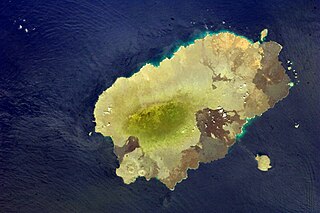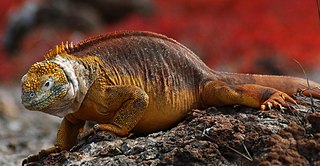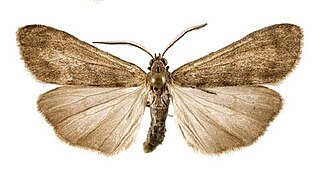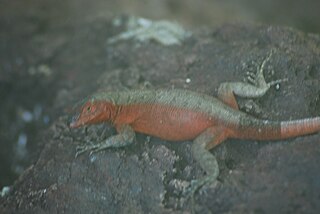
The Tropiduridae are a family of iguanid lizards. The family is sometimes considered a subfamily, Tropidurinae. The subfamily is native to South America, including the islands of Trinidad and the Galápagos. Commonly known as Neotropical ground lizards, most are ground-dwelling animals, and the subfamily includes some lizards adapted to relatively cold climates, including those of the Andes mountains and Tierra del Fuego. Several species give birth to live young.

The Galápagos land iguanas comprise the genus Conolophus of the Galápagos Islands (Ecuador). The number of species of this variable genus has always been disputed; the most current taxonomic surveys suggest that three species exist:

Microlophus is a genus of tropidurid lizards native to South America. Around 20 species are recognized and 10 of these are endemic to the Galápagos Islands, where they are commonly known as lava lizards. The remaining, which often are called Pacific iguanas, are found in the Andes and along the Pacific coasts of Chile, Peru, and Ecuador.

Tropidurus is a genus of reptiles. The genus includes many species of Neotropical ground lizards. Tropidurus is the type genus of the family Tropiduridae.

Santiago Island is one of the Galápagos Islands. The island, which consists of two overlapping volcanoes, has an area of 585 square kilometers (226 sq mi) and a maximum altitude of 907 meters (2,976 ft), atop the northwestern shield volcano. The volcano in the island's southeast erupted along a linear fissure and is much lower. The oldest lava flows on the island date back to 750,000 years ago.

The Galápagos land iguana is a very large, species of lizard in the family Iguanidae. It is one of three species of the genus Conolophus. It is endemic to the Galápagos Islands, in the dry lowlands of the islands of Fernandina, Isabela, Santa Cruz, North Seymour, Baltra, and South Plaza.

Conolophus marthae, the Galápagos pink land iguana, is a species of lizard of the family Iguanidae. This critically endangered iguana is native only to the Wolf Volcano in northern Isabela Island of the Galápagos Islands (Ecuador). It has a pink body with some dark stripes, prompting some to call it the pink iguana or the Galápagos rosy iguana. The species was first discovered in 1986 and was identified as a separate species, distinct from the Galápagos land iguana, early in 2009. This species is the only example of ancient diversification in the genus Conolophus.

Utetheisa connerorum is a moth of the family Erebidae. It is endemic to the Galapagos archipelago, where it is the most widespread of all Utetheisa species. It has been found on Baltra, Fernandina, Floreana, Genovesa, Isabela, Marchena, Pinta, San Cristóbal, Santa Cruz, Santa Fé, and Santiago.

Microlophus delanonis, the Española lava lizard or Hood lava lizard, is endemic to the Galapagos island of Española. The species is commonly attributed to the genus Microlophus but has been attributed to the genus Tropidurus.

Microlophus albemarlensis, the Galápagos Lava lizard, also known as the Albemarle Lava lizard, is a species of Lava lizard. It is endemic to the Galápagos Islands, where it occurs on several islands in the western archipelago: the large islands Isabela, Santa Cruz, Fernandina, Santiago and Santa Fe, as well as several smaller islands: Seymour, Baltra, Plaza Sur, Daphne Major and Rábida. It is the most widespread of the Galápagos species of Microlophus, the others only occurring on single islands. Some authors however, consider populations on Santiago, Santa Cruz, and Santa Fe to be distinct species. The species is commonly attributed to the genus Microlophus but has been historically placed in the genus Tropidurus.

Microlophus bivittatus, the San Cristóbal lava lizard, is a species of lava lizard endemic to San Cristóbal Island in the Galápagos Islands. The species is commonly attributed to the genus Microlophus but has been attributed to the genus Tropidurus. They are currently under threat by invasive cats on the island. The lizard is also closely related to the Microlophus occipitalis which radiated off of the bivittatus.

Microlophus peruvianus, the Peru Pacific iguana, is a species of lava lizard endemic to the Ecuador, Peru, and Chile. The species is commonly attributed to the genus Microlophus but has been attributed to the genus Tropidurus.

Microlophus duncanensis, commonly known as the Pinzón lava lizard, is a species of lava lizard endemic to the Galapagos Island of Pinzón. Although currently classified in the genus Microlophus, it has also been assigned to the genus Tropidurus.

Microlophus grayii, also commonly known as the Floreana lava lizard, Gray's lava lizard, and Gray's Pacific iguana, is a species of lava lizard in the family Tropiduridae. The species is endemic to the Galapagos island of Floreana.

Microlophus habelii, commonly known as the Marchena lava lizard, is a species of lava lizard endemic to the Galapagos island of Marchena.

Microlophus occipitalis, colloquially known as the knobbed Pacific iguana, is a lizard included within the Tropiduridae family. It is a member of the Microlophus genus and thus also considered a lava lizard. The knobbed Pacific iguana is found primarily in Western Peru and Ecuador, lining the coasts. The habitats of the knobbed Pacific iguana can be considered to be both broad and diverse as they are typically found in many different places such as beaches, lomas, and all the way to desert regions. This diversity is furthered as these lizards can also be found in open areas, between rocks, or bushes.

Microlophus koepckeorum, commonly known as Frost's iguana, is a species of lava lizard in the family Tropiduridae. The species is endemic to Peru.

The Santa Cruz lava lizard is a species of lava lizard endemic to the Galapagos island of Santa Cruz.

Microlophus barringtonensis or the Santa Fe lava lizard is a species of lava lizard or a population of Microlophus albemarlensis. It inhabits Santa Fe island in the Galápogos. It is the only lava lizard on Santa Fe. It is extremely common.

The Santiago lava lizard is a species of lava lizard in the family Tropiduridae. They are endemic to the Galapagos islands of Santiago, Bartolomé, Rábida and a few islets. They are also the only lava lizards present on these islands. This species was formerly considered a subpopulation of the Galápagos lava lizard, but is now widely considered as a distinct species.






















